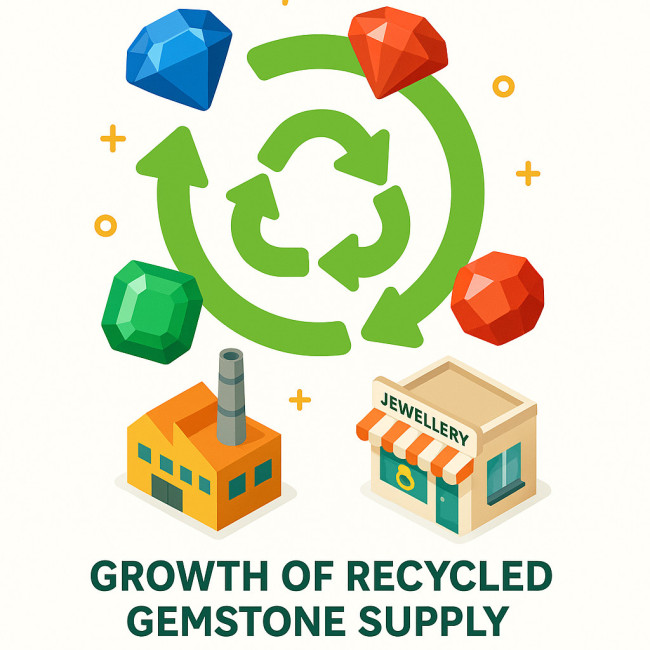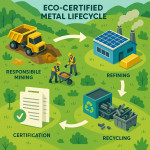Recycled gemstone sourcing: navigate suppliers and certify provenance in 2025
Looking to integrate recycled gemstones into your 2025 jewellery line? This guide walks you through supplier vetting, certification routes, and smart negotiation tactics so you can secure traceable stones that delight eco-conscious clients and regulators alike.
Why recycled gemstone sourcing is surging now
Consumers increasingly link jewellery purchases to social impact. A 2024 KPMG survey shows 63 % of millennials prefer recycled stones over newly mined alternatives. Pair that with stricter import rules in the EU and California, and recycled gemstone sourcing shifts from “nice-to-have” to strategic imperative.
- Lower carbon footprint: Post-consumer stones skip energy-intensive mining.
- Marketing edge: Traceable gems unlock storytelling angles on craft-focused marketplaces.
- Regulatory compliance: Recycled supply chains simplify OECD Due Diligence reporting.
Map the recycled gemstone supply chain
Primary channels in 2025
| Channel | Typical MOQ | Lead time | Certification options |
|---|---|---|---|
| Specialised recyclers | 10 ct+ | 4-8 weeks | RJC CoC, SCS-007 |
| Pawn & estate aggregators | Varies | 2-4 weeks | Appraiser report |
| Industrial reclaim (watch makers, tech) | 50 ct+ | 8-12 weeks | Chain-of-Custody audits |
| Brand take-back programs | N/A | Seasonal | Internal ledger + third-party spot checks |
Key actors to vet
- Collector: gathers post-consumer pieces.
- Processor: removes metal settings, re-cuts stones.
- Sorter & grader: issues condition and quality reports.
- Distributor: sells parcels or calibrated lots.
Supplier due-diligence checklist
Use the checklist below during first calls or factory visits.
- Request a signed declaration of recycled origin aligned with ISO 14021.
- Ask for recent third-party audits (RJC, SCS Global, B Corp).
- Verify the inventory ledger is blockchain-backed or at minimum time-stamped PDFs.
- Confirm HR policies ban child or forced labour, even for sorting tasks.
- Inspect facility for safe lapidary ventilation to reduce silica dust.
Certification pathways explained
1. Responsible Jewellery Council Chain of Custody (CoC)
The RJC CoC standard now includes a “Recycled Gemstone” module. Your supplier undergoes site audits every two years, and you can reference their certificate number in product passports.
2. SCS-007 Sustainability Rated Diamonds & Gemstones
SCS adds climate neutrality, fair labour scoring, and recycled content verification. Although primarily diamond-focused, 2025 revisions open doors for corundum and emerald parcels.
3. Provenance Proof blockchain
Originally designed for emeralds, Provenance Proof issues NFT-style tokens for each stone. This micro-ledger travels with the gem, simplifying resale transparency.
Side-by-side benefits
- Marketing claims: SCS-007 lets you use “Certified Climate Neutral” on packaging.
- Audit depth: RJC covers social, SCS adds environmental, blockchain provides live traceability.
Cost impact and negotiation tips
Recycled gemstone parcels cost 8-15 % more than mixed-provenance parcels today. Offsetting tactics:
- Batch certificates: Certify by lot instead of per stone to trim lab fees 40 %.
- Pre-pay partially: Offer 30 % deposit to secure next-quarter inventory at this year's rates.
- Combine with eco-certified metals orders to negotiate bundled audit visits.
- Leverage MOQ tiers: Some recyclers drop price per carat by 6 % when you cross 25 ct.
Integrate recycled gemstone sourcing into design workflows
Design phase
Share cut-sheet constraints early with CAD teams. Recycled stones come in irregular sizes; designing adjustable prong settings reduces re-cut waste.
Sampling phase
Ship stones in tamper-evident bags containing QR codes linked to chain-of-custody docs—mirroring best practice in recycled glass sourcing.
Launch phase
- Embed certificate numbers in NFC tags under necklace clasps.
- Create landing pages explaining recycled gemstone sourcing benefits; copy UX wins from virtual try-on demo projects.
Marketing: turn provenance into conversions
Consumers trust visual proof. Consider:
- Short reels showing a garnet's “before/after” lapidary journey.
- Interactive timelines that echo approaches used in sustainable material sourcing roadmaps.
- Third-party trust badges in product cards. Test placements A/B—top-left corner often lifts add-to-cart by 7 %.
Legal trends for 2025
The EU Forced Labour Regulation (final text expected Q4 2024) will likely demand proof of ethical origin for all gemstones, including recycled. Keep archived certificates for ten years, and align SKU codes with customs paperwork to avert border delays.
Future outlook

Industry analysts project recycled stones to reach 15 % of global coloured-gem supply by 2027. Forward-thinking brands already lock multi-year contracts with recyclers, mirroring fashion labels' push for circular fabrics via sustainable designer directories. Start negotiations now to dodge scarcity premiums.
Quick self-assessment quiz
FAQ
- Are recycled gemstones always cheaper than newly mined stones?
- No. Processing and certification fees often add 8-15 % to the price, yet storytelling ROI offsets the premium.
- Can lab-grown and recycled stones mix in the same collection?
- Yes, provided you label each SKU clearly and maintain separate certificate records.
- Which coloured stones have the best recycled availability?
- Garnet, amethyst, and sapphire currently top resale inventories due to high jewellery turnover.
- Does the RJC CoC certificate cover vintage gemstones?
- Only if the vintage stones undergo documented chain-of-custody steps post-recovery.
- How long does a typical SCS-007 audit take for a mid-size supplier?
- Four to six weeks, including desktop review and on-site inspections.
Take action today
Secure a pilot parcel with a reputable recycler, align your CAD designs to variable stone sizes, and book your certification slot before Q4. Doing so positions your brand in the eco-luxury vanguard—and keeps you one step ahead of 2025 compliance deadlines.
Ready to elevate your supply chain? Reach out to certified recyclers now and start drafting those chain-of-custody documents before competitors snap up the best lots.











